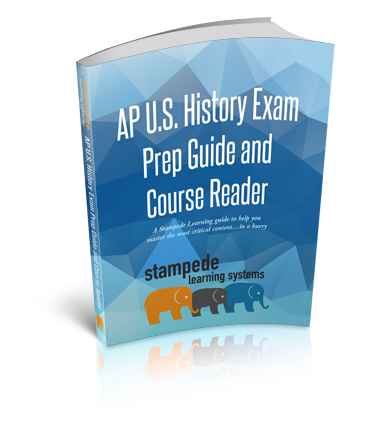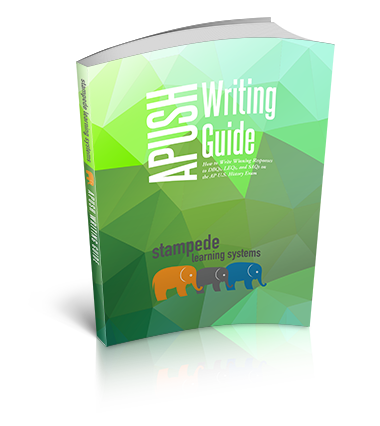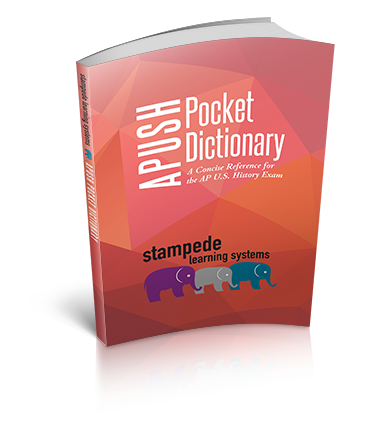How are Stampede Learning Guides Different from Other Test Prep Books?
Our books aren’t like the run-of-the-mill APUSH test prep guides on the market. We don’t include canned multiple-choice practice tests and answer keys. Instead, we focus on high-quality content and exercises to help students develop their critical thinking and historical writing skills.
Are Stampede Learning Guides Best Used in the Classroom or in Self-Directed Study?
Used independently, our books can help highly motivated, self-directed students prepare for the AP U.S. History exam. But where they can make an even bigger difference is in the classroom. Here’s how.
AP U.S. History Exam Prep Guide & Course Reader
 This book is best used under the guidance of an instructor. It *can* be used by a student independently for test prep, but its use is enhanced by an instructor’s lectures and daily reinforcement of the material and concepts.
This book is best used under the guidance of an instructor. It *can* be used by a student independently for test prep, but its use is enhanced by an instructor’s lectures and daily reinforcement of the material and concepts.
We created it as an alternative to the college textbooks used in many APUSH classes, one that combines course content with workbook-style exercises that allow for a workshop model of instruction. Our primary author — a veteran APUSH instructor with a Master’s degree in history — found that the college texts were written so densely and with so much extraneous (albeit interesting) historical detail, to the point that his high school students were having trouble comprehending the material and focusing on the most salient information to prepare for the exam.
Each unit in the book includes a reading that distills the important concepts covered in the college texts into a concise, focused narrative. In addition, each unit features numerous exercises that serve formative assessments meant to stimulate discussion in pairs, small groups, or as a class. These exercises allow for students to explore historical concepts before, during, and after a unit is being taught.
The exercises are varied and numerous. As a result, the book becomes a tool for differentiated instruction. Students have the opportunity to display their understanding in multiple ways. Additionally, for the students who work through exercises more quickly than their classmates, they can be assigned an additional exercise that their classmates (who are working through the material more slowly) will not be expected to complete.
This workbook also helps busy instructors with day-to-day logistics, as they do not have to spend time making copies or fighting with troublesome copy machines. It also reduces the need for the instructor to be concerned with pacing: If a lesson goes faster than expected, the students already have the materials needed to move on to the next reading or exercise. And if a student will be missing class due to a field trip, family trip, or illness, sections from the book can be assigned rather than trying to make copies ahead of schedule for students who will not be in class.
APUSH Writing Guide
 This book is also best used as an instructor-guided resource, but it can more easily be used for self-guided test prep (primarily because it has less information and is therefore easier to navigate without the direction of a teacher).
This book is also best used as an instructor-guided resource, but it can more easily be used for self-guided test prep (primarily because it has less information and is therefore easier to navigate without the direction of a teacher).
Writing effectively in the technical style required for historians is challenging (especially with the DBQ, due to the numerous requirements expected within this form of writing), especially for young writers. Our book breaks down the components of the skills involved in this kind of writing and then guides students to put the skill elements back together to complete a coherent essay.
Instructors love using this book in the classroom because grading and offering feedback on student writing is a time-consuming process; and the faster students become strong writers, the more manageable the teacher’s essay-grading workload becomes.
APUSH Pocket Dictionary
 While this book is not critical for classroom instruction, students find it to be a great resource. Used as a quick-reference guide, our pocket dictionary helps them to improve the quality and efficiency of their study time outside the classroom, both as they work through the material in the workbook and as they complete writing assignments. Students can pair up and use the book to quiz each other on key historical terms and names. The ability to find concise definitions quickly and in a manner that helps them focus on the significance of the terms for their specific study of AP US History saves them time and reduces their stress.
While this book is not critical for classroom instruction, students find it to be a great resource. Used as a quick-reference guide, our pocket dictionary helps them to improve the quality and efficiency of their study time outside the classroom, both as they work through the material in the workbook and as they complete writing assignments. Students can pair up and use the book to quiz each other on key historical terms and names. The ability to find concise definitions quickly and in a manner that helps them focus on the significance of the terms for their specific study of AP US History saves them time and reduces their stress.

